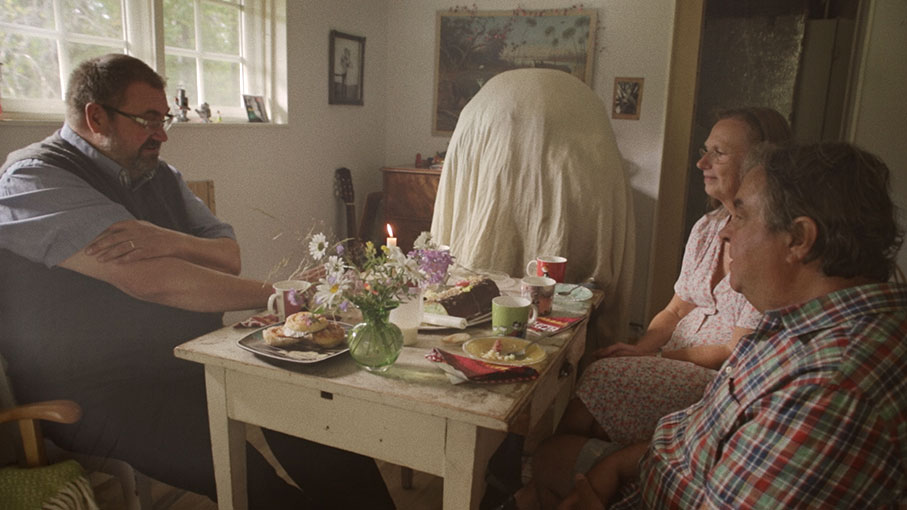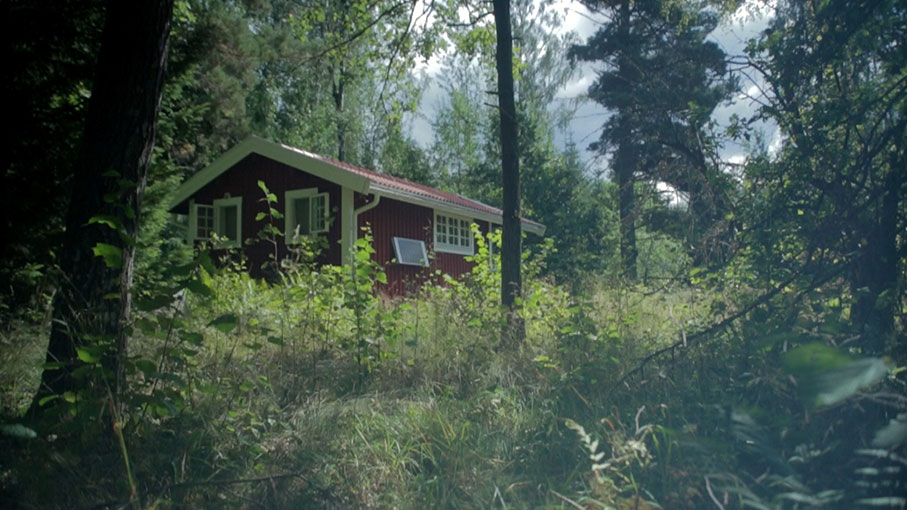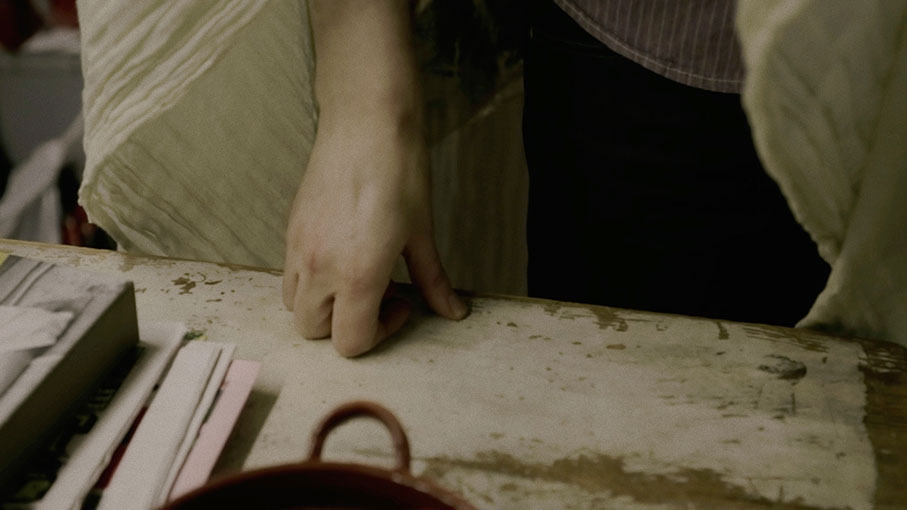|
As Electric Malady opens, the film's protagonist, William Hendelberg, recalls a night of youthful high jinks when he climbed a pine tree to shelter from a sudden downpour, watched the rain tumble from the sky, and felt an equally unexpected surge of joy as he marvelled at the variety of things and his own surely endless possibilities. Back then, he played in several bands, studied too in Borås and Olso, and shot video footage of himself that reveals a fresh-faced, seemingly carefree lad. Those were the days, my friend. 'Life,' he says, 'felt like a large smorgasbord ready to be devoured'. Now, just turned 40, William lives alone in Närke, far from the noise and technology of the city, in a single room lined with tin foil, in an isolated cottage surrounded, ironically, by pine trees.
Maria, his girlfriend of happier days, is now married with kids so she no longer drops in as she once did. William receives few visitors other than his beloved sister, devoted parents, a kindly local priest, and the occasional medical professional interested in the debilitating condition from which he suffers – electrosensitivity, once called 'microwave syndrome' but now officially defined by the World Health Organisation as electromagnetic hypersensitivity (EHS). This little-understood, generally misunderstood illness can cause acutely painful arthralgia, dizziness, heart palpitations, hyperacusis, migraine, nausea, tinnitus and vertigo – all symptoms associated with anxiety, confusion, depression, fatigue, memory loss, insomnia and even suicidal tendencies.
Maria caught this complex, very contemporary illness first, from a hearing-aid-loop system under the counter of the library she worked in. Three fellow librarians, also exposed to high-level charges, subsequently succumbed and then EHS hit William. Soon after he'd taken over Maria's old job part-time, he says, 'it started howling and burning inside my head.' It has not ceased to do so since. William's father, Jan, built a rudimentary Faraday cage for him – in the hope it would provide adequate protection from the electromagnetic radiation that surrounds us all and is emitted by cables, cars, cable cars, computers, cookers, laptops, microwaves, missiles, mobile phones, plugs, spark plugs, power lines, pylons, routers, tablets, toasters, all manner of devices and applications.

Sadly, the cage Jan Hendelberg built for his son, did not suffice, and William's condition progressively worsened. For much of the film he is shielded from the camera's inquisitive eye, buried beneath blankets, submerged under layers of cloth interwoven with insulating copper. This fabric shroud lends him a disembodied, outlandish and otherworldly appearance that recalls David Lynch's The Elephant Man, David Lowery's A Ghost Story and, tellingly, of the IRA's blanket protest in the Maze. William's protective cocoon also reminded this reviewer of the John Lydon's bizarre gauze bondage sleeves – as worn during performances of the Sex Pistols' definitive version of 'God Save the Queen'. Not as fanciful an allusion as you might think for, although William prefers the gentler melodies of Fairport Convention and Lindisfarne, he also likes to pogo to punk occasionally and is happy to brandish his copy of 'Never Mind the Bollocks.'
The priest tells us, on Lidén's behalf, that William is just a normal bloke and that their conversations 'span all registers . . . about books, films, stories, tall tales'. Partly due to thoughts of the mayhem caused by 'normal blokes', a sense of unease begins to creep in as we watch Electric Malady. It is consistently thought-provoking, and some of the thoughts it generates are as unsettling and upsetting as the sight of William's obvious anguish. Sympathetic though we are to his plight, we cannot help wondering what he reads and watches. Nor can we help asking ourselves if William isn't trapped in a role as well as in isolation or noting a certain performative element to the film. Liden has herself spoken of the blurred lines barely separating the psychological and the physiological.
It is ineffably sad to watch William trapped in his illness and isolation – alone, scared, vulnerable, delicate as silk, remote as a distant star. In Cannery Row, John Steinbeck says, 'When you collect marine animals there are certain flat worms so delicate that they are almost impossible to capture whole, for they break and tatter under the touch. You must let them ooze and crawl of their own free will on to a knife blade and then lift them gently into your bottle of sea water.' That passage captures the delicacy and difficulty of the challenge Lidén faced while trying to capture William's elusive individuality and illness. She cannot move too close, she cannot help but zoom in, but William is a mysterious conundrum that, ultimately, cannot be solved, probably not even by himself.
Shot over several years, Marie Lidén's moving mediation on illness, isolation and loneliness inevitably echoes and evokes the unprocessed thoughts and feelings of the pandemic. Those insistent undertones of grand metaphor, though, seldom blur the film's focus on William's solitude and suffering. Electric Malady is, first and foremost, an enthralling, illuminating examination of an invisible illness and the likeable individual beset by it, but it is also a lyrical portrait of loving family. Although the film was rarely invasive or intrusive, we see that love writ large – at mealtimes, at shared celebrations, during various routine visits but, above all, in the respectful way William's parents talk about him and his illness. That love is evident also in the makeshift cage Jan built, in his sister's letters, even in the Moomin mobile and smooth stones his mother gives him for Christmas. Where would he be, would he still be, were it not for their support, patience and love?

When Marie Lidén was a girl, her own mother suffered from EHS. Her family lived without electricity and kept technology at arm's length for many years. Consequently, the Swedish-born, Glasgow-based artist handles her subject with rare delicacy, obvious empathy, and understanding born of experience. Promoted beneath the strapline 'The loneliest form of suffering is to suffer invisibly', Electric Malady ensures this mysterious medical problem is shared, if not halved. William's condition posed endless challenges for Lidén and her tiny crew. Where possible, she kept a respectful distance from William, shot either with a hand-cranked 16mm Bolex or a small hand-held DSLR, and used non-transmitting microphones – all in order to minimise the suffering filming often caused him. Those considerate technical expedients had happy consequences for Lidén's compelling, cumulatively moving film. The camera drives headlong into flurries of downy snow, blackbirds flap across frozen fields, other birds chirrup and caw, towering trees tremble in soft breezes. Images of elemental beauty contrast with others of buzzing pylons and overhead cables. The film's tender lyricism and gentle intimacy leavens its darker, deeply disturbing content. Electric Malady shimmers with rich colours and textures that are mirrored in William's wobblyscope home movie footage. The film is further improved both by the smooth rhythms of David Arthur's evenly-paced editing and William Aikeman's aptly discreet, elegantly melancholic folk-tinged soundtrack.
Lidén allows William to speak on his own behalf and, by inference, on behalf of other sufferers. Intelligent and eloquent, softly spoken and polite, he recounts his tale without anger or bitterness. 'I'm not the slightest bit mentally ill,' he says, 'but I can understand why people might think me paranoid.' He does much to dispel the disbelief, suspicion and mockery familiar to EHS sufferers; much more to combat the kind of attitudes that led one psychoanalyst to assume he was supressing childhood trauma – an unfounded diagnosis that led, in turn, to him being sectioned and dragged to a psychiatric hospital by police. Fortunately, the institution's sympathetic head doctor rescinded the order, but that didn't prevent the local social security agency deciding to withhold the support he so badly needs. 'It's not the first time in history that the victims aren't taken seriously,' William says, citing asbestos, cigarettes and DDT as earlier examples of hugely harmful ignorance. Will we ever learn? Probably not, but William's patience and fortitude under duress, like that of his parents, is a joy to behold.
Lidén's partisan approach, sadly, might not serve EHS sufferers as well as she will have hoped. Her laudable decision to eschew to-camera, talking-head documentary convention in favour of an equally conventional soft news, human-interest appeal to emotion leaves us slightly at sea. Being exceptionally well-informed about EHS herself, being desperately keen to persuade us the illness is real, she second-guesses our every objection, at every turn. With William's example unfolding before our very eyes, we become increasingly convinced that the illness is real, at least for him. Knowing as we do that EHS remains disputed and unproven, though, we cannot help ourselves; we want to know the truth, demand to know the facts, and are disappointed they're not forthcoming.

When the head physician of the local health board visits William, he admits his initial scepticism about William's claims. We smile smugly, sympathetically, and think, ah yes, 'me too'. When William tells him about Maria's disappearance from his life, the doctor's slightly startled reaction gives us further pause for thought. When William says, 'Most people must think I'm exaggerating', the word 'indeed' forms fast. Might his split with Maria, which he doesn't discuss and about which we're told nothing, have been some kind of fatal final straw? Might he not have buckled, nursed his anger and grief, and subsequently struggled to re-engage with life? Might that alone not explain a lot, even if it doesn't tell the whole story? As William says, 'Time is relative'. Even a decade can pass in a blur.
Such seemingly cruel and heartless speculation, we realise with horror, must dog William's days. Our hearts go out to him. Ludicrous suggestions anyway, surely? Anyone in possession of the inner strength to face the wailing winds of loneliness down a decade would surely have the means to stay afloat, no? And yet our doubts persist. Knowing as we do that William is extremely sensitive as well as electrosensitive, we wonder if his illness didn't provide cover for a tragic flight from a cruel, noisy brutal world. We crave 'the truth' but it proves as elusive as the illness itself. Finally, we must settle for a spread bet of contending, often contradictory 'truths' and remind ourselves that you can never see inside a soul.
As if those added layers of discomforting doubt weren't unsettling enough, Electric Malady opens up a positive pandora's box of questions seldom asked. William's retreat from the world becomes emblematic of the pandemic, of a collective trauma from which we awoke as if from a nightmare – only to emerge, unchanged, into the blazing inferno of climate collapse. If William's salutary experiences of solitude and suffering reflect and refract intense memories of covid times, it also begs similarly discomforting questions about alienation, anomie and, as the film's title suggests, our relationship to technology.
Both Electric Malady and Tom Hayden's BBC film about three EHS sufferers ask the same pertinent question: are we being Tortured By Technology? The Guardian went slightly further online, boldly titling Thomas Ball's film on electrosensitivity, Is Technology Killing Us? In nominally post-industrial, post-scarcity societies such as ours, William's native Sweden, technology is, of course, pervasive. How do you go off grid if the grid is everywhere? There are 72 billion mobile phones in the world, 72 million in the UK alone. By contrast, there are now fewer than 20,000 of the Gilbert Scott phone boxes that once splashed bright red right across the island of my boyhood. We have come far, fast. From the arrival of the internet, through the early warnings about mobile phone radiation, to the era of Zoom the pace of change was relentless and faster than the human eye. Already, our growing reliance on mobile devices has changed the way we watch films and see the world and ourselves. Short-form clips that shrink images and attention spans are now more popular than films or TV programmes. Do extremely sensitive electrosensitives like William send us warning signals from the outer edges of the Second Machine Age - stark reminders of the price we pay for that tendency towards acceleration, rationalisation, and dehumanisation initiated by Frederick W. Taylor, refined by Henry Ford, and made manifest in the suffering of electrosensitives?

Are electrosensitives like William the vanguard, sounding a general retreat from the accelerated extractive economy, or exceptions that prove the rule of the happy coexistence of man and machine? Do these damaged souls not, perhaps, point to hidden dangers lurking in technological plenitude? As the farmer-philosopher Masanobu Fukuoka says, 'There has never been a generation like the present where human hearts are so badly wounded. This is true of every area of society – politics, economics, education and culture. It is reflected in the degradation of the environment, which has come about through the material path humanity has chosen.' By highlighting the elusiveness of silence do electrosensitives not embody condemnation of technology's vast white noise?
Few films raise as many questions as Electric Malady, few leave so many unanswered. A factory of facts this film ain't. No bad thing, that, because William is a symbol of the unknowable. His loneliness stands for all we lived through during lockdowns – when the lonely got lonelier, the damaged more damaged, the sad sadder, and we relied on technology as never before. In Alone Together: Why We Expect More from Technology and Less from Each Other, Sherry Turkle says, 'Technology proposes itself as the architect of our intimacies. These days it suggests substitutions that put the real on the run . . . Technology is seductive when what it offers meets our human vulnerabilities. And as it turns out, we are very vulnerable indeed. We are lonely but fearful of intimacy . . . Overwhelmed by the volume and velocity of our lives, we turn to technology to help us find time. But technology makes us busier than ever and ever more in search of retreat.' So, paradoxically, we retreat into the technological.
Marie Lidén may not have all the answers (who does?!), but she raises questions aplenty. Electric Malady, like Kim Hopkins' delightful documentary A Bunch of Amateurs, manages to be simultaneously disturbing and reassuring, dispiriting and uplifting. The respective struggles of a sensitive Swedish recluse and an embattled Yorkshire film club might not, at first glance, appear to have much in common, but both films tug insistently at our heartstrings while offering hope of redemptive resolution. William and the film club gamely battle on, and there's hope to be found, too, in the mere fact that their respective stories have now been told, and circulated. Surely, the films will call forth the help so desperately needed. Lidén and Hopkins received nominations at the 25th British Independent Film Awards, reminding us that you don't need a big budget if you have a big heart, huge talent, and a startling story to tell. In A Bunch of Amateurs, the cineastes of Bradford attempt to make their own version of Oklahoma on a micro-budget. There's little hint of Hollywood in Lidén's darker, more contemplative gem, but she deftly deploys the same sense of thrifty invention and demonstrates a similar superabundance of empathy and tenderness. We're only two months into the year, but Electric Malady has already staked an irrefutable claim to be considered one of the most delicately-crafted, thought-provoking and heart-rending films of the year.
Electric Malady screens at the ICA on 28 February – which will be followed by a Q&A with director Marie Lidén, hosted by ICA Cinema Curator Nicolas Raffin – and in cinemas nationwide from 3 March. |